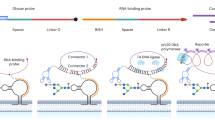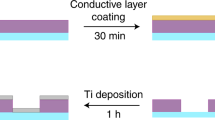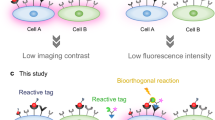Abstract
Most lectins bind carbohydrate ligands with relatively low affinity, making the identification of optimal ligands challenging. Here we introduce a point accumulation in nanoscale topography (PAINT) super-resolution microscopy method to capture weak glycan–lectin interactions at the single-molecule level in living cells (Glyco-PAINT). Glyco-PAINT exploits weak and reversible sugar binding to directly achieve single-molecule detection and quantification in cells and is used to establish the relative kon and koff rates of a synthesized library of carbohydrate-based probes, as well as the diffusion coefficient of the receptor–sugar complex. Uptake of ligands correlates with their binding affinity and residence time to establish structure–function relations for various synthetic glycans. We reveal how sugar multivalency and presentation geometry can be optimized for binding and internalization. Overall, Glyco-PAINT represents a powerful approach to study weak glycan–lectin interactions on the surface of living cells, one that can be potentially extended to a variety of lectin–sugar interactions.

This is a preview of subscription content, access via your institution
Access options
Access Nature and 54 other Nature Portfolio journals
Get Nature+, our best-value online-access subscription
$29.99 / 30 days
cancel any time
Subscribe to this journal
Receive 12 print issues and online access
$259.00 per year
only $21.58 per issue
Buy this article
- Purchase on Springer Link
- Instant access to full article PDF
Prices may be subject to local taxes which are calculated during checkout






Similar content being viewed by others
Data availability
The datasets generated and/or analyzed during the current study are available from the corresponding author on reasonable request.
References
Ghazarian, H., Idoni, B. & Oppenheimer, S. B. A glycobiology review: carbohydrates, lectins and implications in cancer therapeutics. Acta Histochem. 113, 236–247 (2011).
Kumar, K. K. et al. Biological role of lectins: a review. J. Orofac. Sci. 4, 20–25 (2012).
Holmskov, U., Thiel, S. & Jensenius, J. C. Collectins and ficolins: humoral lectins of the innate immune defense. Annu. Rev. Immunol. 21, 547–578 (2003).
Dam, T. K. & Brewer, C. F. Lectins as pattern recognition molecules: the effects of epitope density in innate immunity. Glycobiology 20, 270–279 (2010).
Lundquist, J. J. & Toone, E. J. The cluster glycoside effect. Chem. Rev. 102, 555–578 (2002).
Kiessling, L. L., Gestwicki, J. E. & Strong, L. E. Synthetic multivalent ligands in the exploration of cell-surface interactions. Curr. Opin. Chem. Biol. 4, 696–703 (2000).
Martinez‐Pomares, L. The mannose receptor. J. Leukoc. Biol. 92, 1177–1186 (2012).
Leteux, C. et al. The cysteine-rich domain of the macrophage mannose receptor is a multispecific lectin that recognizes chondroitin sulfates A and B and sulfated oligosaccharides of blood group Lewis A and Lewis X types in addition to the sulfated N-glycans of lutropin. J. Exp. Med. 191, 1117–1126 (2000).
Fiete, D. J., Beranek, M. C. & Baenziger, J. U. A cysteine-rich domain of the ‘mannose’ receptor mediates GalNAc-4-SO4 binding. Proc. Natl Acad. Sci. USA 95, 2089–2093 (1998).
Biessen, E. L. et al. Lysine-based cluster mannosides that inhibit ligand binding to the human mannose receptor at nanomolar concentration. J. Biol. Chem. 271, 28024–28030 (1996).
Blum, J. S., Stahl, P. D., Diaz, R. & Fiani, M. L. Purification and characterization of the d-mannose receptor from J774 mouse macrophage cells. Carbohydr. Res. 213, 145–153 (1991).
Taylor, M. E. & Drickamer, K. Structural requirements for high affinity binding of complex ligands by the macrophage mannose receptor. J. Biol. Chem. 268, 399–404 (1993).
Napper, C. E., Dyson, M. H. & Taylor, M. E. An extended conformation of the macrophage mannose receptor. J. Biol. Chem. 276, 14759–14766 (2001).
Burgdorf, S., Kautz, A., Bohnert, V., Knolle, P. A. & Kurts, C. Distinct pathways of antigen uptake and intracellular routing in CD4 and CD8 T cell activation. Science 316, 612–616 (2007).
Burgdorf, S., Schölz, C., Kautz, A., Tampé, R. & Kurts, C. Spatial and mechanistic separation of cross-presentation and endogenous antigen presentation. Nat. Immunol. 9, 558–566 (2008).
East, L. & Isacke, C. M. The mannose receptor family. Biochim. Biophys. Acta 1572, 364–386 (2002).
Garcia-Vallejo, J. J. & van Kooyk, Y. The physiological role of DC-SIGN: a tale of mice and men. Trends Immunol. 34, 482–486 (2013).
Hu, Z. et al. Structural insights into the pH-dependent conformational change and collagen recognition of the human mannose receptor. Structure 26, 60–71 (2018).
Frison, N. et al. Oligolysine-based oligosaccharide clusters: selective recognition and endocytosis by the mannose receptor and dendritic cell-specific intercellular adhesion molecule 3 (icam-3)-grabbing nonintegrin. J. Biol. Chem. 278, 23922–23929 (2003).
Feinberg, H. et al. Structural analysis of carbohydrate binding by the macrophage mannose receptor CD206. J. Biol. Chem. 296, 100368 (2021).
Kéry, V., Křepinský, J. J. F., Warren, C. D., Capek, P. & Stahl, P. D. Ligand recognition by purified human mannose receptor. Arch. Biochem. Biophys. 298, 49–55 (1992).
Lee, S. J. et al. Mannose receptor-mediated regulation of serum glycoprotein homeostasis. Science 295, 1898–1901 (2002).
DeSchoolmeester, M. L., Martinez‐Pomares, L., Gordon, S. & Else, K. J. The mannose receptor binds Trichuris muris excretory/secretory proteins but is not essential for protective immunity. Immunology 126, 246–255 (2009).
Dan, J. M., Kelly, R. M., Lee, C. K. & Levitz, S. M. Role of the mannose receptor in a murine model of Cryptococcus neoformans infection. Infect. Immun. 76, 2362–2367 (2008).
Dangaj, D. et al. Mannose receptor (MR) engagement by mesothelin GPI anchor polarizes tumor-associated macrophages and is blocked by anti-MR human recombinant antibody. PLoS ONE 6, e28386 (2011).
Martinez‐Pomares, L. et al. Analysis of mannose receptor regulation by IL-4, IL-10, and proteolytic processing using novel monoclonal antibodies. J. Leukoc. Biol. 73, 604–613 (2003).
Sharonov, A. & Hochstrasser, R. M. Wide-field subdiffraction imaging by accumulated binding of diffusing probes. Proc. Natl Acad. Sci. USA 103, 18911–18916 (2006).
Jungmann, R. et al. Multiplexed 3D cellular super-resolution imaging with DNA-PAINT and Exchange-PAINT. Nat. Methods 11, 313–318 (2014).
Delcanale, P. et al. Aptamers with tunable affinity enable single-molecule tracking and localization of membrane receptors on living cancer cells. Angew. Chem. Int. Ed. Engl. 59, 18546–18555 (2020).
Kiuchi, T., Higuchi, M., Takamura, A., Maruoka, M. & Watanabe, N. Multitarget super-resolution microscopy with high-density labeling by exchangeable probes. Nat. Methods 12, 743–746 (2015).
Giannone, G. et al. Dynamic superresolution imaging of endogenous proteins on living cells at ultra-high density. Biophys. J. 99, 1303–1310 (2010).
Winckler, P. et al. Identification and super-resolution imaging of ligand-activated receptor dimers in live cells. Sci. Rep. 3, 2387 (2013).
Li, R.-J. E. et al. Systematic dual targeting of dendritic cell C-type lectin receptor DC-SIGN and TLR7 using a trifunctional mannosylated antigen. Front. Chem. 7, 650 (2019).
Small, A. & Stahlheber, S. Fluorophore localization algorithms for super-resolution microscopy. Nat. Methods 11, 267–279 (2014).
Brockman, J. M. et al. Live-cell super-resolved PAINT imaging of piconewton cellular traction forces. Nat. Methods 17, 1018–1024 (2020).
Neumann, A. K., Thompson, N. L. & Jacobson, K. Distribution and lateral mobility of DC-SIGN on immature dendritic cells–implications for pathogen uptake. J. Cell Sci. 121, 634–643 (2008).
Liu, Y., Misulovin, Z. & Bjorkman, P. J. The molecular mechanism of sulfated carbohydrate recognition by the cysteine-rich domain of mannose receptor. J. Mol. Biol. 305, 481–490 (2001).
Clayton, A. H. A. Fluorescence-based approaches for monitoring membrane receptor oligomerization. J Biosci. 43, 463–469 (2018).
Gambin, Y. et al. Lateral mobility of proteins in liquid membranes revisited. Proc. Natl Acad. Sci. USA 103, 2098–2102 (2006).
Naji, A., Levine, A. J. & Pincus, P. A. Corrections to the Saffman–Delbrück mobility for membrane bound proteins. Biophys. J. 93, L49–L51 (2007).
Chung, I. et al. Spatial control of EGF receptor activation by reversible dimerization on living cells. Nature 464, 783–787 (2010).
Low-Nam, S. T. et al. ErbB1 dimerization is promoted by domain co-confinement and stabilized by ligand binding. Nat. Struct. Mol. Biol. 18, 1244–1249 (2011).
Corzo, J. Time, the forgotten dimension of ligand binding teaching. Biochem. Mol. Biol. Educ. 34, 413–416 (2006).
Vigerust, D. J., Vick, S. & Shepherd, V. L. Stable expression and characterization of an optimized mannose receptor. J. Clin. Cell. Immunol. 6, 330 (2015).
Llorca, O. Extended and bent conformations of the mannose receptor family. Cell. Mol. Life Sci. 65, 1302–1310 (2008).
Gazi, U. & Martinez-Pomares, L. Influence of the mannose receptor in host immune responses. Immunobiology 214, 554–561 (2009).
Prigozy, T. I. et al. The mannose receptor delivers lipoglycan antigens to endosomes for presentation to T cells by CD1b molecules. Immunity 6, 187–197 (1997).
Mahnke, K. et al. The dendritic cell receptor for endocytosis, Dec-205, can recycle and enhance antigen presentation via major histocompatibility complex class II–positive lysosomal compartments. J. Cell Biol. 151, 673–684 (2000).
Jahagirdar, P., Lokhande, A. S., Dandekar, P. & Devarajan, P. V. in Mannose Receptor and Targeting Strategies (eds. Jahagirdar, P. et al.) 433–456 (Springer International Publishing, 2019).
Tokunaga, M., Imamoto, N. & Sakata-Sogawa, K. Highly inclined thin illumination enables clear single-molecule imaging in cells. Nat. Methods 5, 159–161 (2008).
Daly, R., Vaz, G., Davies, A. M., Senge, M. O. & Scanlan, E. M. Synthesis and biological evaluation of a library of glycoporphyrin compounds. Chem. Eur. J. 18, 14671–14679 (2012).
Wong, C. S., Hoogendoorn, S., van der Marel, G. A., Overkleeft, H. S. & Codée, J. D. C. Targeted delivery of fluorescent high-mannose-type oligosaccharide cathepsin inhibitor conjugates. ChemPlusChem 80, 928–937 (2015).
Chan, W. and White, P. Fmoc Solid Phase Peptide Synthesis: A Practical Approach (Oxford Scholarship Online, 1999); https://oxford.universitypressscholarship.com/view/10.1093/oso/9780199637256.001.0001/isbn-9780199637256
Acknowledgements
R.R. and L.A. thank the European Research Council/Horizon 2020 for financial support (no. ERC-StG-757397). L.A. thanks NWO for support (VIDI grant no. 192.028). L.A. thanks the Barcelona Institute of Science and Technology for support. This work was funded by the NWO gravitation program 2013 granted to the Institute for Chemical Immunology (no. ICI-024.002.009) (T.P.H. and J.D.C.C.); NWO BBoL grant (W.D.); and the European Research Council (grant no. ERC-CoG-865175, S.I.v.K.).
Author information
Authors and Affiliations
Contributions
R.R., T.P.H., J.D.C.C., S.I.v.K. and L.A. conceived the experiments. R.R. performed microscopy. T.P.H. synthesized the probe library. W.D. synthesized propargyl GalNAc 33 and repeated synthesis of certain probes. Y.N. performed SPR experiments. E.B. provided the CHO-MR cell line. The manuscript was written by R.R. and T.H. in consultation with S.P., J.D.C.C., S.I.v.K. and L.A.
Corresponding authors
Ethics declarations
Competing interests
The authors declare no competing interests.
Additional information
Peer review information Nature Chemical Biology thanks Khalid Salaita, Ben Schumann and the other, anonymous, reviewer(s) for their contribution to the peer review of this work.
Publisher’s note Springer Nature remains neutral with regard to jurisdictional claims in published maps and institutional affiliations.
Supplementary information
Supplementary Information
Supplementary Figs. 1–8 and note on the synthesis and characterization of reagents.
Rights and permissions
About this article
Cite this article
Riera, R., Hogervorst, T.P., Doelman, W. et al. Single-molecule imaging of glycan–lectin interactions on cells with Glyco-PAINT. Nat Chem Biol 17, 1281–1288 (2021). https://doi.org/10.1038/s41589-021-00896-2
Received:
Accepted:
Published:
Issue Date:
DOI: https://doi.org/10.1038/s41589-021-00896-2



